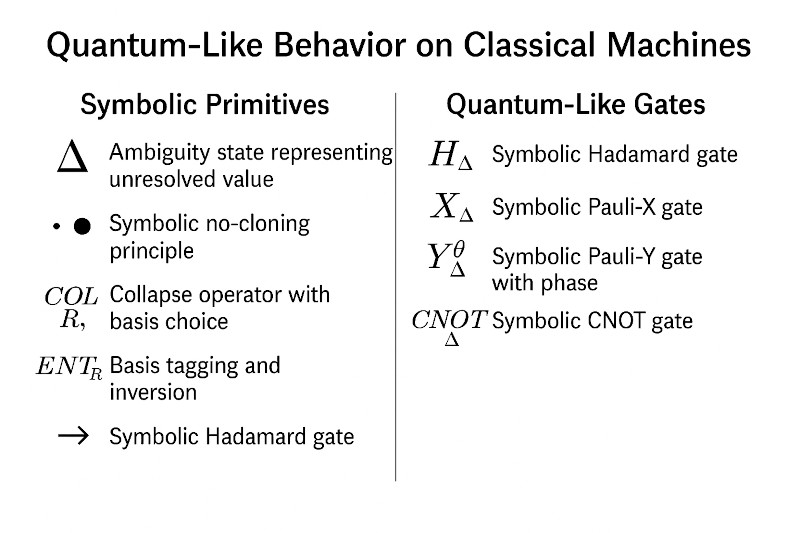At the core of the Triangle Symbolic Processing Framework (TSPF) lies a family of symbolic primitives that simulate quantum‑like behaviors in classical environments. These primitives do not use quantum hardware, but they offer a deterministic approximation of key quantum phenomena such as ambiguity, collapse, entanglement, basis sensitivity, and symbolic no‑cloning. Together, they form the foundation for a logic architecture that mimics quantum gates using classical symbolic representations.

1. Ambiguity State (Δ)
The ambiguity symbol Δ represents a symbolic register in an unresolved state. It is not a classical 0 or 1, nor a probabilistic superposition, but rather an epistemic uncertainty—a logical symbol that signifies an unresolved bit. Registers in the Δ state cannot be copied or duplicated because their value is undefined. Any attempt to clone or inspect Δ prematurely forces collapse, irreversibly resolving it. This enforces the symbolic no‑cloning principle, mirroring the spirit of the quantum no‑cloning theorem.
2. Collapse Operator
Collapse is defined using the operator COL_Δ(R, B), which takes a symbolic register R (in state Δ) and a basis B (usually X or Z).
- If B matches the initialization basis, collapse is deterministic, yielding the correct bit.
- If B differs, collapse still resolves Δ but outputs a random bit, injecting symbolic entropy.
Once collapsed, R becomes fixed (0 or 1) and Δ is destroyed. This operation satisfies three key constraints:
- Irreversibility
- Symbolic no‑cloning
- Basis sensitivity
3. Basis Tagging
Each Δ register is initialized with a hidden basis (X or Z). During collapse, only if the chosen basis matches this tag will collapse be coherent. This tagging is essential for BB84-style protocols, ensuring alignment is only determined post-collision.
4. Entanglement Primitive
The primitive ENT(R₁, R₂) symbolically links two Δ registers across agents. Collapsing one leads to the correlated collapse of the other:
- If bases match, both parties register the same bit.
- If bases mismatch, divergent outcomes occur—simulating Bell‑pair behavior for E91 protocols.
5. Logical Operations
- SYM_NOT(R): Inverts a resolved bit. Applied pre‑collapse, it influences collapse logic deterministically.
Derived Quantum‑Like Gates
QSymbolic builds on the core primitives—ambiguity (Δ), collapse (COL_Δ), entanglement (ENT), no‑cloning, phases—to define symbolic counterparts of quantum gates. Although fully classical and deterministic, these gates mirror key conceptual properties of their quantum analogues:
Symbolic Hadamard (H_Δ)
Analogous to the quantum Hadamard gate—which transforms a definite state |0⟩ or |1⟩ into an equal superposition (\|0⟩ + \|1⟩)/√2 —H_Δ takes a resolved bit (0 or 1) and maps it to Δ, assigning a random hidden basis (X or Z). This introduces epistemic ambiguity, enabling basis-dependent collapse behavior.
Symbolic Pauli‑X (X_Δ)
Mirrors the quantum Pauli‑X (bit‑flip) gate, which swaps |0⟩ to |1⟩ . Symbolically, X_Δ inverts a resolved bit (post-collapse). Applied pre-collapse, it flips the expected outcome when matched against the initialization basis, impacting collapse prediction in entangled contexts.
Symbolic Pauli‑Y (Y_Δ)
Inspired by the quantum Pauli‑Y gate—combining bit‑flip and phase‑flip (π rotation around the y-axis) —Y_Δ performs a symbolic bit-flip and appends a phase tag (θ). While bits flip, mismatched basis collapse reveals symbolic “phase displacement,” aiding traceability of collapse errors or adversarial intervention.
Symbolic Pauli‑Z (Z_Δ)
Modeled after the quantum Pauli‑Z (phase‑flip) gate , Z_Δ does not alter bit value but sets a phase tag θ. Under correct basis, it’s inert. With mismatched basis, the phase tag becomes observable, offering a semantic trace of the collapse event and basis misalignment.
Symbolic CNOT (CNOT_Δ)
A proxy for the quantum controlled‑NOT gate: if control register A collapses to 1, SYM_NOT flips target register B. If A→0, B remains unchanged. This conditional symbolic behavior emulates quantum conditional logic and can propagate entanglement or symbolic coupling effects within TSPF.
Collapse Chains & Entanglement Behavior
When entangled via ENT(R₁, R₂), Δ registers form a symbolic collapse chain: collapsing one forces a correlated collapse in its partner. This mirrors quantum observer cascades, and when combined with symbolic gates, enables logical operations akin to quantum circuits—all while enforcing no‑cloning, irreversible collapse, and basis‑sensitive behaviors.
| Gate | Symbolic Effect | Notes |
|---|---|---|
| H_Δ (Symbolic Hadamard) | Turns a resolved bit (0 or 1) into Δ, assigns randomized hidden basis (X/Z) | Introduces epistemic ambiguity for superposition-like behavior |
| X_Δ (Symbolic Pauli‑X) | Flips resolved bit; if Δ, toggles collapse expectation | Models parity inversion or NOT behavior under collapse |
| Y_Δ (Symbolic Pauli‑Y) | Flip + attach symbolic phase θ if Δ | Useful for traceability under mismatched basis collapse |
| Z_Δ (Symbolic Pauli‑Z) | Adds symbolic phase tag θ (no bit flip) | Detectable when collapse basis is mismatched |
| CNOT_Δ (Symbolic CNOT) | If control resolves to 1, target bit is flipped; Δ collapses accordingly | Simulates control‑target logic via symbolic inversion |
Collapse Chains
When entangled, resolving one Δ triggers correlated collapse across its chain—mimicking the observer-induced collapse propagation seen in quantum systems.
Summary
TSPF primitives include:
- Δ – Ambiguity register
- COL_Δ(R, B) – Collapse operation
- ENT(R₁, R₂) – Symbolic entanglement
- SYM_NOT(R) – Logical inversion
- θ – Phase tag
From these, symbolic gates—Hadamard, Pauli‑X, Pauli‑Y, Pauli‑Z, CNOT—emerge. These constructs enforce symbolic no‑cloning, irreversible collapse, and basis‑dependent divergence.
While not genuinely quantum, QSymbolic delivers deterministic symbolic analogues for quantum behaviors, enabling classical architectures with post‑quantum simulation, symbolic keying, and secure logic propagation—all without quantum hardware.
PATENT PENDING
https://github.com/Frank-QSymbolic/symbolic-primitives/blob/main/README.md
Leave a Reply